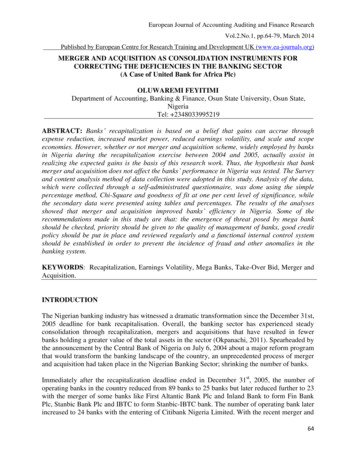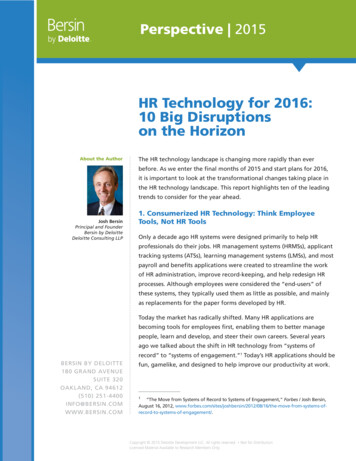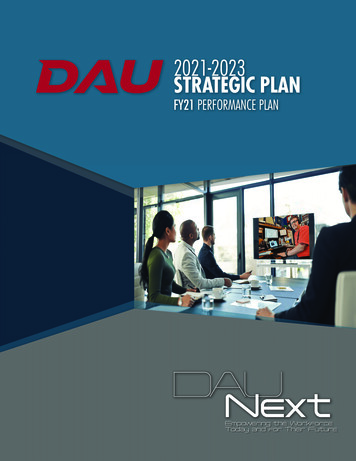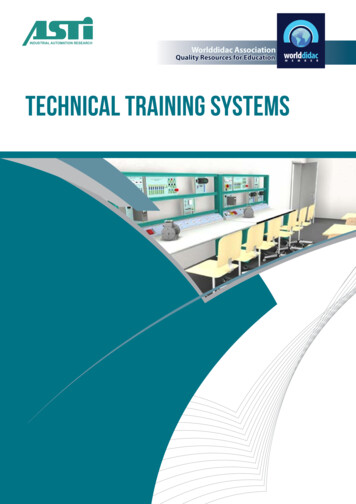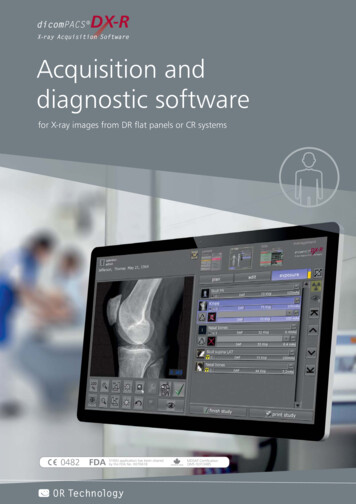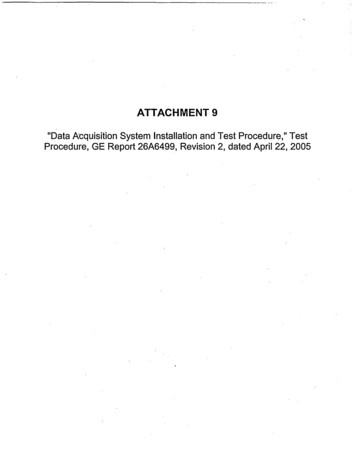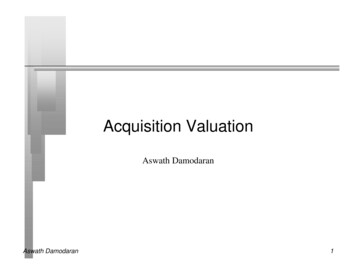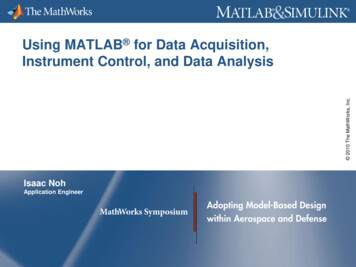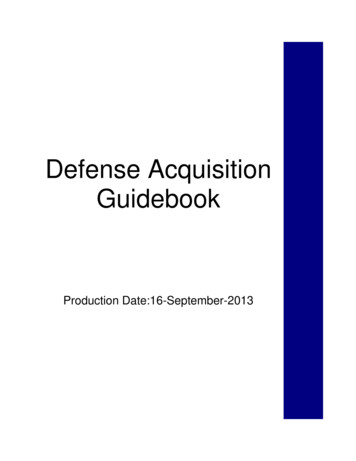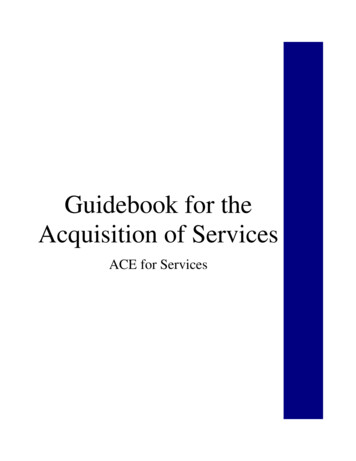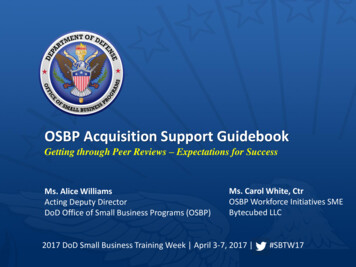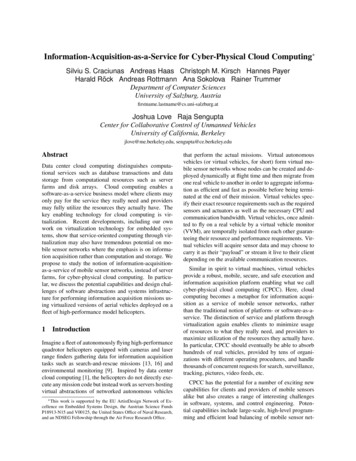
Transcription
Information-Acquisition-as-a-Service for Cyber-Physical Cloud Computing Silviu S. Craciunas Andreas Haas Christoph M. Kirsch Hannes PayerHarald Röck Andreas Rottmann Ana Sokolova Rainer TrummerDepartment of Computer SciencesUniversity of Salzburg, Austriafirstname.lastname@cs.uni-salzburg.atJoshua Love Raja SenguptaCenter for Collaborative Control of Unmanned VehiclesUniversity of California, Berkeleyjlove@me.berkeley.edu, sengupta@ce.berkeley.eduAbstractData center cloud computing distinguishes computational services such as database transactions and datastorage from computational resources such as serverfarms and disk arrays. Cloud computing enables asoftware-as-a-service business model where clients mayonly pay for the service they really need and providersmay fully utilize the resources they actually have. Thekey enabling technology for cloud computing is virtualization. Recent developments, including our ownwork on virtualization technology for embedded systems, show that service-oriented computing through virtualization may also have tremendous potential on mobile sensor networks where the emphasis is on information acquisition rather than computation and storage. Wepropose to study the notion of information-acquisitionas-a-service of mobile sensor networks, instead of serverfarms, for cyber-physical cloud computing. In particular, we discuss the potential capabilities and design challenges of software abstractions and systems infrastructure for performing information acquisition missions using virtualized versions of aerial vehicles deployed on afleet of high-performance model helicopters.1IntroductionImagine a fleet of autonomously flying high-performancequadrotor helicopters equipped with cameras and laserrange finders gathering data for information acquisitiontasks such as search-and-rescue missions [13, 16] andenvironmental monitoring [9]. Inspired by data centercloud computing [1], the helicopters do not directly execute any mission code but instead work as servers hostingvirtual abstractions of networked autonomous vehicles This work is supported by the EU ArtistDesign Network of Excellence on Embedded Systems Design, the Austrian Science FundsP18913-N15 and V00125, the United States Office of Naval Research,and an NDSEG Fellowship through the Air Force Research Office.that perform the actual missions. Virtual autonomousvehicles (or virtual vehicles, for short) form virtual mobile sensor networks whose nodes can be created and deployed dynamically at flight time and then migrate fromone real vehicle to another in order to aggregate information as efficient and fast as possible before being terminated at the end of their mission. Virtual vehicles specify their exact resource requirements such as the requiredsensors and actuators as well as the necessary CPU andcommunication bandwidth. Virtual vehicles, once admitted to fly on a real vehicle by a virtual vehicle monitor(VVM), are temporally isolated from each other guaranteeing their resource and performance requirements. Virtual vehicles will acquire sensor data and may choose tocarry it as their “payload” or stream it live to their clientdepending on the available communication resources.Similar in spirit to virtual machines, virtual vehiclesprovide a robust, mobile, secure, and safe execution andinformation acquisition platform enabling what we callcyber-physical cloud computing (CPCC). Here, cloudcomputing becomes a metaphor for information acquisition as a service of mobile sensor networks, ratherthan the traditional notion of platform- or software-as-aservice. The distinction of service and platform throughvirtualization again enables clients to minimize usageof resources to what they really need, and providers tomaximize utilization of the resources they actually have.In particular, CPCC should eventually be able to absorbhundreds of real vehicles, provided by tens of organizations with different operating procedures, and handlethousands of concurrent requests for search, surveillance,tracking, pictures, video feeds, etc.CPCC has the potential for a number of exciting newcapabilities for clients and providers of mobile sensorsalike but also creates a range of interesting challengesin software, systems, and control engineering. Potential capabilities include large-scale, high-level programming and efficient load balancing of mobile sensor net-
Figure 1: The JAviator quadrotor helicopter [6].works. Interesting challenges are, in software and systems engineering, virtual vehicle migration to and isolation on real vehicles as well as, in control engineering,multiplexing flight control. For example, multiple virtual vehicles on the same real vehicle may require different flight plans that need to be properly negotiated bythe VVM. The problem may be simplified by having realvehicles follow flight plans that are pre-determined bythe vehicle provider. In this case, virtual vehicles do notalter the flight plans of real vehicles but may still migrate from one real vehicle to another. Vehicle migration across wireless links is nevertheless challenging andmay only be possible with small-footprint, light-payloadvirtual vehicles. Vehicle isolation is another key challenge that involves non-trivial, real-time process scheduling and management.Next, we discuss our existing hardware infrastructure,which we plan to use as CPCC platform: a fleet often high-performance quadrotor helicopters called JAviators [6]. Then, in Section 3, we describe a Xen-basedversion of our virtual machine monitor [4], which weare currently enhancing for CPCC. Finally, in Section 4,we discuss potential CPCC capabilities and challenges inmore detail.2HelicopterWe have designed and built, entirely from scratch, ahigh-performance quadrotor helicopter called JAviator(Java Aviator) [6] as shown in Figure 1. In particular, we have designed and built the frame and the onboard power electronics as detailed below. The motorswere built for us according to our specifications. Thesensors, the rotor blades, the computer board, and thebattery are off-the-shelf components. The JAviator hasoriginally served as our “flying testbed” to demonstrateflight control software written in Java with our collaborators at IBM Research. In the meantime, we have alsoused the JAviator to demonstrate flight control softwareand systems infrastructure written in C. We are currentlyable to fly the JAviator navigated manually but with automatic attitude and altitude control. Right now there areten identical machines of which five are fully equippedand ready to fly. We have recently started working onautomatic position control for autonomous indoor (byultra-wide-band localization) and outdoor (by differential GPS) multi-vehicle flight.The JAviator is, as the term “quadrotor” suggests, a4-rotor helicopter. The advantage of a 4-rotor aircraftis that it can be built without a means for cyclic pitchcontrol, as required in conventional single-main-rotor designs. A quadrotor is therefore mechanically simpler andless expensive to build. However, quadrotors can only beflown by computer, controlling at least its attitude andaltitude, which makes them an ideal platform for demonstrating software capabilities. Compared to most otherquadrotor research aircraft that are in wide use today,we aimed to go beyond the prototypical stage of usually ungainly looking contraptions and tried to providesomething professional looking right from the beginning.For this purpose, we developed an aircraft that not onlystands out with its high robustness and payload capacity,but also achieves a high degree of utilization and demonstrative impact. One special feature of the JAviator thatmakes it unique is its fully symmetrical airframe, resulting from a similar top and bottom frame. The JAviatorhas an overall diameter (diagonal over rotors) of 1.3 mand an empty weight of 2.2 kg, including the batteryand all onboard electronics. Due to the incorporationof custom-built brushless motors, which are significantlystronger than conventional motors, the JAviator’s propulsion system generates a maximum lift of 5.4 kg, whichtranslates into a theoretical maximum payload of 3.2 kg.Without payload the average flight time is around 30 min,a maximum of 40 min was achieved during tests whilehovering in ground effect.The JAviator is currently equipped with an inertialmeasurement unit, one ultrasonic and two laser dis-
tance sensors, and a so-called Robostix-Gumstix stack,which serves as the onboard computer system. The Robostix contains an Atmel ATmega128 processor clockedat 16 MHz and provides the necessary communicationinterfaces to connect to the many different sensors. It further provides the required PWM units for driving the fourmotors. The Gumstix features an Intel XScale PXA270CPU clocked at 600 MHz, a 128-MB RAM, and a 32MB flash memory. The operating system on the Gumstixis a Linux system running a kernel version with realtime extensions and support of high-resolution timers,which we modified to work with the Gumstix. Attitude and altitude control is done on the Gumstix, whichreceives the necessary sensor data from the Robostixand then sends the computed actuator updates back tothe Robostix. The JAviator ground station comprises alaptop computer, a 4-axis joystick for piloting the helicopter, and a separate logging workstation. All groundcomputers run Linux and are connected via WLAN tothe onboard computers. All relevant material includinghardware blueprints, pictures, and videos is available atjaviator.cs.uni-salzburg.at.The JAviator is designed to carry significant payloadsuch as additional sensors and even non-embedded computers. We are now working on mounting at least awebcam and a small-formfactor server-grade multi-coreboard connected to the webcam and the onboard Gumstix onto the JAviator. The result is that the JAviator willbecome a flying server with two key physical capabilitiesthat a traditional server does not have: non-trivial sensing and three-dimensional mobility. The JAviator serverwill be hosting our VVM as well as any virtual vehicles“flying” on the JAviator. Ideally, the JAviator server willeventually replace the Gumstix, if the monitor can provide sufficient real-time guarantees for low-level control(in the order of 100Hz rates and 1ms latencies). Attitude,altitude, and position control will then be performed by avirtual vehicle rather than the Gumstix. The Robostix is,however, even more difficult to replace since most sensors and actuators require special I/O devices not available on off-the-shelf, non-embedded hardware.3Virtual Vehicle MonitorVirtualization allows multiple operating systems to sharea single, physical machine through encapsulation in socalled domains created by a virtual machine monitor orhypervisor. A virtual vehicle monitor (VVM) is essentially a virtual machine monitor enhanced for CPCC. Thearchitecture of our virtualization system is depicted inFigure 2. The VVM is based on the open-source Xenhypervisor [2]. Similar to a virtual machine monitor, themain tasks of the VVM are domain scheduling, I/O handling, and memory isolation.Privileged nManagerI/O SchedulerOSVVOSVVOSVVOSOScredit-vCPU credit-vCPUEDF-vCPUEDF-vCPUEDF-vCPUcredit-vCPU credit-vCPUVirtual Vehicle MonitorHybrid EDF-Credit SchedulerCPU1CPU2CPU3CPU4MemorySSDNetworkUSBFigure 2: Virtualization architecture for CPCC.In addition to the spatial domain isolation provided bythe Xen hypervisor, the VVM provides temporal domainisolation using enhanced scheduling mechanisms as described below. The VVM runs at least one privilegeddomain that contains device drivers and enables otherdomains to perform I/O by handling their I/O requests.Moreover, the privileged domain contains domain management tools and a CPCC manager. The domain management tools provide functionality to create and destroydomains, initiate migration of domains, and modify thescheduling parameters of domains. The CPCC manager connects the VVM with other VVMs in the cyberphysical cloud. Based on the domain management toolsits main job is to create and destroy virtual vehicles andmanage migration between different VVMs. The VVMalso supports domains running general purpose operatingsystem instances, e.g. a Linux system that runs legacyapplications such as a web server.In the following we discuss the main elements of ourvirtualization system in more detail.CPU Scheduling In the Xen hypervisor the unit ofscheduling is a so-called virtual CPU (vCPU), which isan abstraction of a physical CPU. The default schedulerin Xen, called credit scheduler, is tuned for high throughput and good fairness among all active vCPUs in the system. However, the credit scheduler does not provide lowlatency or guaranteed CPU shares.We have developed a hybrid EDF-credit scheduler forour VVM that can schedule a vCPU using either the standard credit scheduler (credit-vCPU) or alternatively anearliest-deadline-first scheduler (EDF-vCPU) [5]. Thehybrid EDF-credit scheduler provides low latency and allows to specify a guaranteed CPU share for EDF-vCPUswhile still achieving high throughput for credit-vCPUs.The implementation of the hybrid EDF-credit scheduleruses a run-queue for each physical CPU and applies workstealing and dynamic migration of vCPUs in order tobalance the workload across all available physical CPUcores. Moreover, it supports dynamically switching a
vCPU from a credit-vCPU to an EDF-vCPU and viceversa. All scheduling parameters are adjustable throughthe domain management tools.Virtual Vehicle Domains Virtual vehicles are hostedinside domains running a special-purpose virtual vehicle operating system (VVOS). The memory footprint ofa virtual vehicle domain, including the VVOS, the application code and the data, should be small enough toachieve minimal down-time when migrating. Additionally, small domains provide fast deployment when creating and starting new virtual vehicles. Virtual vehicles runon EDF-vCPUs for temporal isolation, while legacy applications, which do not require strong temporal guarantees, run in domains that are deployed on credit-vCPUs.We are currently working on a VVOS to bootstrap andhost the run-time infrastructure for virtual vehicles. Itis a single-address-space operating system that implements basic thread scheduling and device drivers for virtual I/O devices only. A virtual I/O device provides awell-defined interface that abstracts the low-level detailsof the underlying real I/O device, which is accessible byprivileged domains only. A virtual device connects to aprivileged domain that contains the device driver for thereal I/O device. The privileged domain accesses the I/Odevice on behalf of the connected domain. Moreover,since multiple virtual vehicles can share a single device,the privileged domain performs I/O scheduling for all incoming I/O requests from various virtual vehicles.I/O Scheduling Virtual vehicles not only require temporally deterministic execution of their program code butalso temporally deterministic handling of their I/O requests. In order to support given latency and throughput requirements of a virtual device, the privileged domain applies I/O scheduling among all virtual devicescurrently connected to a real device. The I/O schedulerin the privileged domain uses a hierarchical token buckettraffic-shaping algorithm to regulate the packet flow froma virtual device to the real device.Virtual Vehicle Migration Domain migration in general and virtual vehicle migration in particular is a keymechanism for CPCC. For example, it is possible for asingle virtual vehicle to change its geographical locationmuch faster than it is for a real vehicle. A virtual vehiclecan simply migrate at the speed of the communicationlink to a real vehicle that is closer to its target location.Currently, our VVM supports migration of running domains as provided by the Xen hypervisor [3]. Since ourvirtual vehicle domains have a small memory footprintand do not have much dynamically changing state thelive-migration mechanism of Xen should be sufficient.However, using a low-bandwidth wireless connection between real vehicles for migration could require more sophisticated algorithms. For instance, migration overheadcan be reduced by applying memory compression algorithms on the migrating domain [11].4CPCC Capabilities and ChallengesTraditional virtualization technology provides resourceand data isolation and is therefore one of the key enablingtechnologies for scalable and secure cloud computing.Instead of maintaining and running their own machines,clients are only required to specify (and pay for) theirexact performance requirements, which are then met byadequate virtual machines in the cloud. For clients, theadvantage, besides reduced costs, is more flexibility andcapabilities and, for providers, more control over systemutilization and reliability. Moreover, virtualization reduces the developement and maintainance effort [12, 14].Virtualization in CPCC, if adapted properly, may alsoprovide similar benefits but also entirely new capabilities. For example, the notion of a virtual vehicle mayenable multiple clients to share a single real vehicle butuse it for different purposes. A virtual vehicle flying on agiven real vehicle may provide interesting flight dynamics when migrating to other, possibly distant vehicles atthe speed of their communication links. Moreover, theinvolved real vehicles may have entirely different flightand sensor capabilities and even be operated by differentproviders. In the event of an imminent real vehicle crash(as in physical crash), virtual vehicles may “evacuate”to nearby real vehicles in order to save their potentiallyvaluable information payload.Traditional virtualization technology typically implements machine or process models that are only deterministic in terms of functional behavior. Repeated execution of sequential programs in these models is guaranteedto compute the same output for the same input. However, other non-functional properties such as executiontime and energy consumption may vary and may evenbe unbounded (mostly due to complex resource sharing). Virtualization technology for CPCC must therefore include solutions that provide deterministic behavior beyond computing mathematical functions. Determinism with respect to non-functional properties such astime, space, and energy is key to compositionality andthus scalability of the involved engineering methods andtools [4].Traditional data centers utilize virtualization technology and, in particular, virtual machine migration mostlyfor load balancing (LAN migration [3]) but also for accommodating increasing communication demand suchas high throughput and low latency requirements (WANmigration [17, 18]). With CPCC the actual number and
location of server machines becomes even more relevant since sensor location and live communication arekey factors. Moreover, servers also move in space now,not just virtual machines. Already challenging problemsrelated to resource allocation, scheduling, and management become even more difficult in this context.Next, we discuss our plans for developing CPCC onthree levels of abstraction: (1) virtual vehicles as the keyCPCC infrastructure, (2) virtual information aggregatorsforming virtual networks of virtual vehicles that provideinformation-acquisition-as-a-service for CPCC, and (3) amission language for scalable CPCC programming.CPCC Infrastructure. A virtual vehicle is an abstraction of a real vehicle. It provides resources for computation and communication, such as a scripting engine forour mission language and a wireless link, as well as access to sensors and actuators. In order to fly a virtualvehicle, it must be instantiated by providing a programimplemented in our mission language that determines itsfunctional and timing behavior. For example, the program may specify not only what to do but also how longa particular activity is supposed to take. During flight,the vehicle maintains its program state as well as its control state such as its geographical location and speed. Interestingly, similar to virtual machines in data centers,it may not be necessary for virtual vehicles to know onwhich real vehicle they are currently flying, or whether itis actually sharing a real vehicle with other virtual vehicles.The real vehicle can be controlled through the privileged domain similarly to other hardware such as CPUsand wireless cards. Again, I/O scheduling becomes necessary as several virtual vehicles may co-exist on anyreal vehicle. However, there are many CPCC applications, such as search-and-rescue [13, 16] or environmental monitoring [15], where it is desired to give the virtualvehicles some authority to change or modify the trajectory of a real vehicle. The correct methods and levelsof abstraction at which to do this is an ongoing area ofresearch.One option is to allow scheduled control of individual actuators by virtual vehicles through the privilegeddomain. Each actuator device would have a driver thatthe privileged domain exposes to virtual vehicles throughvirtual devices. This low-level control approach becomes complicated as certain sets of actuators must becontrolled consistently to retain vehicle stability. Forinstance, allowing virtual vehicle A to control altitudewhile virtual vehicle B controls attitude may result in undesired behaviors or even instability and a crash of thereal vehicle.Alternatively, a virtual vehicle could control the realvehicle through a set of high-level control behaviors pro-vided as services by the real vehicle [10]. The privilegeddomain would connect the real vehicle’s services to different virtual devices that represent the different controlservices. These high-level control services (e.g. trackline, go to point) would have beneath their invocation arobust and stable low-level real-time controller that thereal vehicle’s operator has developed, tested, and validated. This allows the real vehicle’s operator to guarantee their vehicle’s operation and protect their investment from poorly written virtual vehicles, while at thesame time allowing more abstract and more compact virtual vehicles to be written, which would ease both development and communication. A vehicle scheduler inthe privileged domain would then schedule the accessof the virtual vehicles to the real vehicle. This couldbe implemented such that only one virtual vehicle is incontrol of the entire real vehicle at any one segment oftime, or it could attempt to execute a combination of nonconflicting virtual vehicle behaviors simultaneously, e.g.fly to point A and search area C, which contains point A.CPCC Service. A network of virtual vehicles may beused for collaborative missions to gather sensor data. Avirtual vehicle network (VVN) may specify the collaborating virtual vehicles and their requirements on the communication performance in the network. The specifiedcommunication performance, for instance, may limit thefreedom on which real vehicles the virtual vehicles of theVVN are deployed and migrated since some of the realvehicles might be too far apart to communicate at thespecified rate. Alternatively, a VVN may also specifygeographical proximity directly as requirement if communication performance is not an issue, e.g. for formation flight [7].A VVN is created by instantiating the participatingvirtual vehicles on real vehicles based on their performance as well as initial geographical location and flightplan requirements. A virtual vehicle network monitor(VVNM) running on a central server, similar to a nameserver, will be in charge of tracking real vehicles bymaintaining a database of their CPCC managers’ state(resources, geographical location, flight plan, and identifiers of the hosted virtual vehicles). The database isonly updated by real vehicles through their CPCC manager, which report their state back to the network monitor across a possibly low-bandwidth but long-range communication link. All other communication, in particularvirtual vehicle communication and migration traffic, maybe done across possibly independent, high-bandwidth yetshort-range links. For this purpose, non-trivial ad-hocnetworking protocols and a distributed VVNM may increase performance and reliability, but may cost additional communication and computation due to the required synchronization of information.
In order to find a suitable real vehicle to migrate to,a virtual vehicle may ask the VVNM for migration targets based on available resources, location, flight plan,and other virtual vehicles (but not real vehicles). Forexample, a virtual vehicle may migrate because of theavailability of certain sensors in a specific location, or tofollow another virtual vehicle. This is where the distinction of virtual and real vehicles, that is, service and platform, pays off. Virtual vehicles work with more abstractand thus more robust notions of resources and controlstate while real vehicles may improve robustness independently of the virtual vehicles’ behavior.CPCC Programming. A mission language is a coordination language for describing the information acquisition behavior of mobile sensors. A mission is a distributed program written in a mission language. The execution of a mission is successful if the desired sensor datais made available as data streams with specified transmission rates in a central location such as a server. For example, a search-and-rescue mission may involve multiple mobile sensors streaming high-resolution still imagesalong with temperature data from a range of different locations to a central server. The key challenge in the design of a mission language is to capture the creation, update, and termination of missions for mobile sensors. Wehave already obtained promising results with the designof a mission language called the Collaborative SensingLanguage (CSL) [10]. We are developing CSL by further adapting its semantics to a service-oriented notionof virtual vehicles and networks described above. Here,the emphasis is on identifying the correct abstractions fordealing with concurrent and changing sets of real and virtual vehicles and networks. CSL, in its existing form, isbased on the notion of tasks and the assignment of tasksto vehicles [8]. Virtual vehicles are essentially a richer,fully programmable and service-oriented form of tasks.They will allow ’arbitrary tasks’ to be generated fromthe provided services of the real vehicles. An extensionof CSL will incorporate the enriched semantics and offerinformation-acquisition-as-a-service rather than the existing platform-oriented view.5SummaryWe proposed information-acquisition-as-a-service ofmobile sensor networks for cyber-physical cloudcomputing (CPCC), and presented a fleet of highperformance model helicopters as possible target platform and virtualization technology enhanced for CPCC.We also discussed potential capabilities and design challenges of software abstractions and systems infrastructure for CPCC information acquisition missions.References[1] A RMBRUST, M., F OX , A., G RIFFITH , R., J OSEPH , A. D.,K ATZ , R. H., KONWINSKI , A., L EE , G., PATTERSON , D. A.,R ABKIN , A., S TOICA , I., AND Z AHARIA , M. Above the clouds:A Berkeley view of cloud computing. Tech. rep., EECS Department, University of California, Berkeley, Feb 2009.[2] BARHAM , P., D RAGOVIC , B., F RASER , K., H AND , S.,H ARRIS , T., H O , A., N EUGEBAUER , R., P RATT, I., ANDWARFIELD , A. Xen and the art of virtualization. In Proc. SOSP(2003), ACM.[3] C LARK , C., F RASER , K., H AND , S., H ANSEN , J., J UL , E.,L IMPACH , C., P RATTN , I., AND WARFIELD , A. Live migrationof virtual machines. In Proc. NSDI (2005), USENIX.[4] C RACIUNAS , S., K IRSCH , C., PAYER , H., R ÖCK , H., ANDS OKOLOVA , A. Programmable temporal isolation in real-timeand embedded execution environments. In Proc. IIES (2009),ACM.[5] C RACIUNAS , S., K IRSCH , C., PAYER , H., R ÖCK , H., ANDS OKOLOVA , A. Programmable temporal isolation throughvariable-bandwidth servers. In Proc. SIES (2009), IEEE.[6] C RACIUNAS , S., K IRSCH , C., R ÖCK , H., AND T RUMMER , R.The JAviator: A high-payload quadrotor UAV with high-levelprogramming capabilities. In Proc. GNC (2008), AIAA.[7] G IRARD , A., AND H EDRICK , K. Formation control of multiple vehicles using dynamic surface control and hybrid systems.International Journal of Control 76, 9 (2003), 913–923.[8] G ODWIN , M., S PRY, S., AND H EDRICK , J. Distributed collaboration with limited communication using mission state estimates.In Proc. ACC (2006), IEEE.[9] H ART, J., AND M ARTINEZ , K. Environmental sensor networks:A revolution in the earth system science? Earth-Science Reviews78 (2006), 177–191.[10] H EDRICK , K., JARIYASUNANT, J., K IRSCH , C., L OVE , J.,P EREIRA , E., S ENGUPTA , R., AND Z ENNARO , M. CSL: A language to specify and re-specify mobile sensor network behaviors.In Proc. RTAS (2009), IEEE.[11] J IN , H., D ENG , L., W U , S., S HI , X., AND PAN , X. Live virtualmachine migration with adaptive, memory compression. In Proc.CLUSTER (2009), IEEE.[12] L EVIS , P., AND C ULLER , D. Maté: a tiny virtual machine forsensor networks. In Proc. ASPLOS (2002), ACM.[13] M C G EE , T., AND H EDRICK , K. Guaranteed strategies to searchfor mobile evaders in the plane. In Proc. ACC (2006), IEEE.[14] M ÜLLER , R., A LONSO , G., AND KOSSMANN , D. A virtualmachine for sensor networks. SIGOPS Oper. Syst. Rev. 41, 3(2007), 145–158.[15] R ATHINAM , S., DE A LMEIDA , P. P., K IM , Z., JACKSON , S.,T INKA , A., G ROSSMAN , W., AND S ENGUPTA , R. Autonomoussearching and tracking of a river using an UAV. In Proc. ACC(2007), IEEE.[16] RYAN , A., AND H EDRICK , J. A mode-switching path plannerfor UAV-assisted search and rescue. In Proc. CDC-ECC (2005),IEEE.[17] T RAVOSTINO , F., DASPIT, P., G OMMANS , L., J OG , C.,DE L AAT, C., M AMBRETTI , J., M ON
called domains created by a virtual machine monitor or hypervisor. A virtual vehicle monitor (VVM) is essen-tially a virtual machine monitor enhanced for CPCC. The architecture of our virtualization system is depicted in Figure 2. The VVM is based on the open-source Xen hypervisor [2]. Similar to a virtual machine monitor, the

